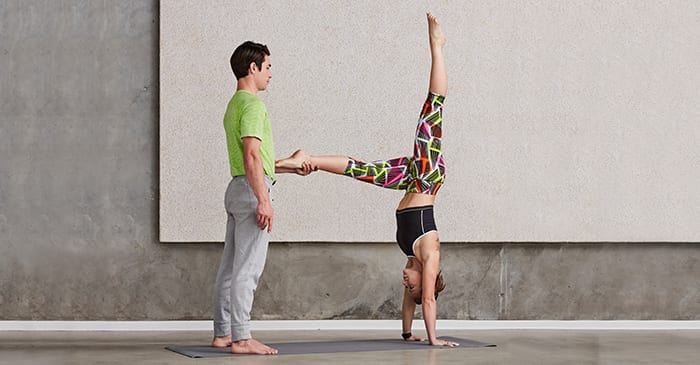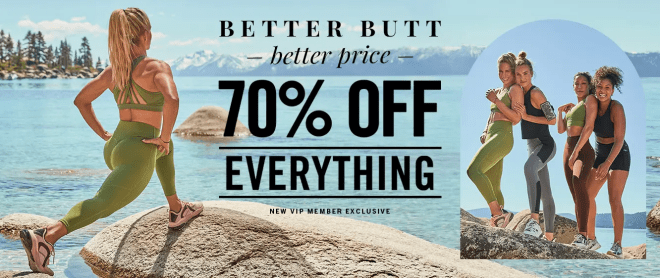Grab a partner and get upside down! This partner sequence will introduce your body to the practice of hand-standing: from opening up your shoulders, to building core strength for proper alignment, to holding inversions with a spotter.
First things first. Things to consider before you start:
• Communication with your partner is key! Use a word like “down” before you reach your personal limit, so you have enough energy to come down safely with control.
• Warm up your wrists. If you feel pain in your hands or wrists, stop. Strength is built little by little. If you listen to your body, your handstand will come more quickly (and without injury!) than if you push too far, too fast.
• The times specified in each of these exercises are just suggested starting points–listen to your body to determine increments that work for you at your current ability level. Start small and watch your times increase as your strength grows!

Open the shoulders with a PARTNER SHOULDER OPENER: The flexibility of your shoulders can come between you and your ability to achieve/hold a handstand.
1. Stand facing your partner at arms-length apart and rest your hands on each other’s shoulder tops.
2. Bow toward one another until you are both at 90 degrees.
3. Your partner’s hands will slide down your back. Gently draw your chest in, as if back toward your spine, and into the resistance of your partner’s hands. Keep the breath continuous.
Hold for 1 minute (or as long as comfortable). Repeat at least 2x.
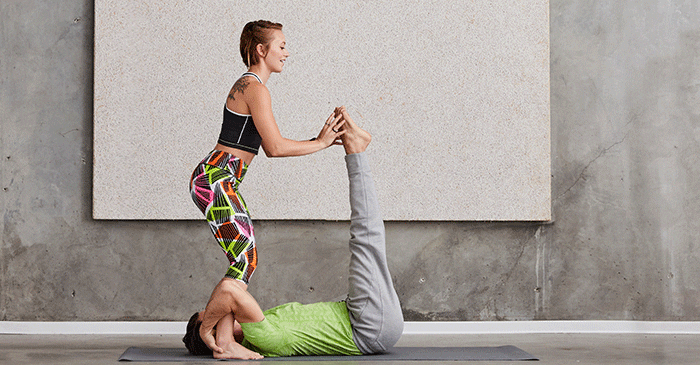
Learn to engage your lower abdominals with the LEG TOSS: Strong lower abdominals are crucial to holding the alignment necessary to stay inverted.
1. Partner A lies on their back and lifts their legs to 90 degrees, while holding onto Partner B’s ankles.
2. Partner B is standing on either side of Partner A’s ears, with their knees bent (to protect their back as they toss).
3. Partner B uses a C-grip (hands are shaped like the letter C) around each of Partner A’s ankles to toss their legs.
4. Partner B tosses Partner A’s legs towards the ground, varying at random between a toss to the left, middle, or right to keep Partner A from using momentum to do the work.
Toss for 1 minute. Partner A and B switch roles. Repeat 2x each.

Get used to the alignment of a handstand in the PLANK TEST: Think about balancing an object on the end of your finger–a rigid object would be much easier to balance than a bendy one!
1. Partner A lies on their back with arms tight by their sides.
2. Partner B stands in a wide stance on either side of Partner A’s feet. Use a C-grip to lift Partner A by the ankles to about a 30-degree angle.
3. Partner A engages their core, inner thighs, and arms to maintain a plank position as they are lifted
4. Partner B releases one leg at a time, randomizing the pattern, while Partner A maintains the body engagement in attempt to keep their feet together
Hold for 1 minute. Partner A and B switch roles. Repeat 2x each.
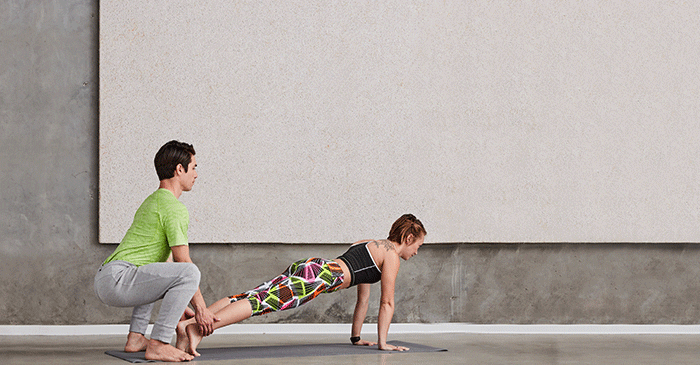
Put that alignment to practice while inverted in the PARTNER L-STAND: Proper alignment allows you to hold a handstand with less effort (eventually very little!). This exercise opens your shoulders and familiarizes your body with what it feels like to have your hips “stacked” directly over your shoulders.
1. Partner A holds a plank pose with their fingers spread apart and index fingers parallel.
2. Partner B grips Partner A at the ankles and slowly lifts their legs as Partner A folds at the hips until their hips are stacked directly over their shoulders.
Hold for 20 seconds.
3. Partner A then lifts one leg until stacked over their hips. (Partner B can help direct Partner A to know when their leg is stacked directly over their hips and shoulders)
4. To come down, Partner B releases one of Partner A’s legs at a time to lower to the ground.
5. Switch legs 5x each, holding each side for 10-15 seconds. Partner A and B switch roles.
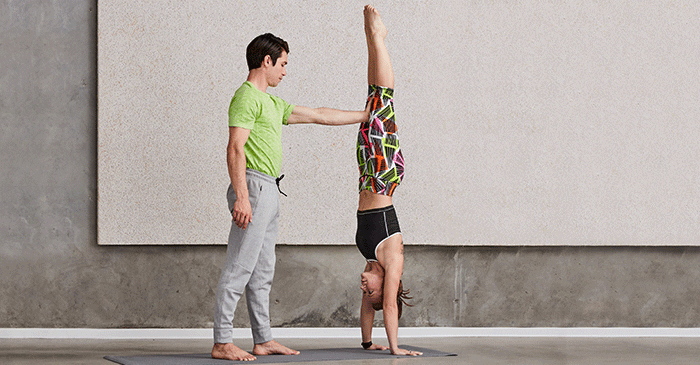
Hold a handstand with a THIGH SPOT: Put all the elements together and build muscle memory using a spotter. The interior squeeze of the thighs not only acts as a spotting mechanism, but also helps the body engage in a handstand!
1. Partner A and Partner B repeat the steps from the previous exercise to get into the L-Shape.
2. Once Partner A has the left leg lifted and stacked, Partner B guides their right leg to stack beside the left.
3. Partner B makes a fist and places it just above Partner A’s knees between their thighs.
4. Partner A squeezes their inner thighs around Partner B’s fist to engage their middle body.
5. Partner A lifts out of their shoulders, as if pushing the ground away.
6. Partner A presses firmly through the palm surface closest to the fingers (the platform below the knuckles) to keep most of the weight out of the wrists.
7. To come down, Partner B steps away and Partner A straddles their legs to the ground.
8. Partner B times Partner A so they can watch their progress over time! Partner A and B switch roles.
Ash Witham, Fabletics Master
